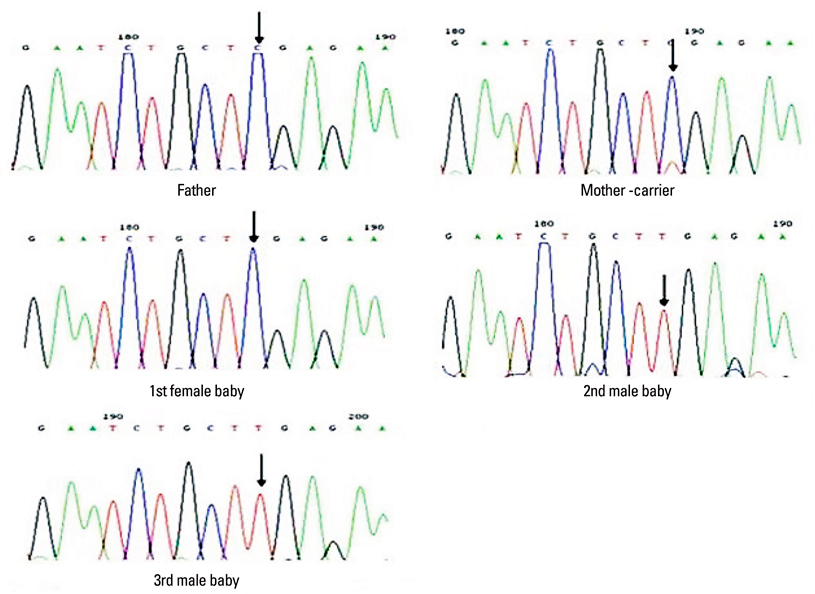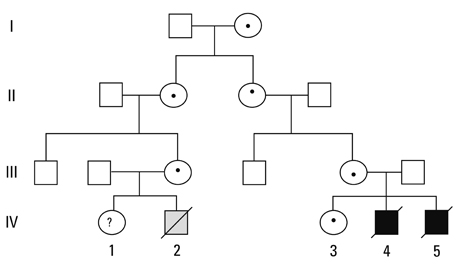Yonsei Med J.
2011 May;52(3):547-550. 10.3349/ymj.2011.52.3.547.
X-linked Myotubular Myopathy in a Family with Two Infant Siblings: A Case with MTM1 Mutation
- Affiliations
-
- 1Department of Pediatrics, CHA Gangnam Medical Center, CHA University, Seoul, Korea.
- 2Department of Pediatrics, Severance Children's Hospital, Yonsei University College of Medicine, Seoul, Korea. lchul63@yuhs.ac
- 3Department of Clinical Genetics, Severance Children's Hospital, Yonsei University College of Medicine, Seoul, Korea.
- 4Department of Pathology, Yonsei University College of Medicine, Seoul, Korea.
- KMID: 1777032
- DOI: http://doi.org/10.3349/ymj.2011.52.3.547
Abstract
- X-linked myotubular myopathy (XLMTM) is a rare congenital muscle disorder, caused by mutations in the MTM1 gene. Affected male infants present severe hypotonia, and generalized muscle weakness, and the disorder is most often complicated by respiratory failure. Herein, we describe a family with 2 infants with XLMTM which was diagnosed by gene analysis and muscle biopsy. In both cases, histological findings of muscle showed severely hypoplastic muscle fibers with centrally placed nuclei. From the family gene analysis, the Arg486STOP mutation in the MTM1 gene was confirmed.
MeSH Terms
Figure
Reference
-
1. Riggs JE, Bodensteiner JB, Schochet SS Jr. Congenital myopathies/dystrophies. Neurol Clin. 2003. 21:779–794.
Article2. Spiro AJ, Shy GM, Gonatas NK. Myotubular myopathy. Persistence of fetal muscle in an adolescent boy. Arch Neurol. 1966. 14:1–14.3. Pierson CR, Tomczak K, Agrawal P, Moghadaszadeh B, Beggs AH. X-linked myotubular and centronuclear myopathies. J Neuropathol Exp Neurol. 2005. 64:555–564.
Article4. Laporte J, Biancalana V, Tanner SM, Kress W, Schneider V, Wallgren-Pettersson C, et al. MTM1 mutations in X-linked myotubular myopathy. Hum Mutat. 2000. 15:393–409.
Article5. Noguchi S, Fujita M, Murayama K, Kurokawa R, Nishino I. Gene expression analyses in X-linked myotubular myopathy. Neurology. 2005. 65:732–737.
Article6. Laporte J, Hu LJ, Kretz C, Mandel JL, Kioschis P, Coy JF, et al. A gene mutated in X-linked myotubular myopathy defines a new putative tyrosine phosphatase family conserved in yeast. Nat Genet. 1996. 13:175–182.
Article7. Laporte J, Guiraud-Chaumeil C, Tanner SM, Blondeau F, Hu LJ, Vicaire S, et al. Genomic organization of the MTM1 gene implicated in X-linked myotubular myopathy. Eur J Hum Genet. 1998. 6:325–330.
Article8. McEntagart M, Parsons G, Buj-Bello A, Biancalana V, Fenton I, Little M, et al. Genotype-phenotype correlations in X-linked myotubular myopathy. Neuromuscul Disord. 2002. 12:939–946.
Article9. Collins JE, Collins A, Radford MR, Weller RO. Perinatal diagnosis of myotubular (centronuclear) myopathy: a case report. Clin Neuropathol. 1983. 2:79–82.10. Sustersic B, Neubauer D. 'Long-term survivor with X-linked myotubular myopathy'. Dev Med Child Neurol. 2005. 47:358–359.
Article11. Yu S, Manson J, White S, Bourne A, Waddy H, Davis M, et al. X-linked myotubular myopathy in a family with three adult survivors. Clin Genet. 2003. 64:148–152.
Article12. Chanzy S, Routon MC, Moretti S, de Gennes C, Mselati JC. [Unusual good prognosis for X-linked myotubular myopathy]. Arch Pediatr. 2003. 10:707–709.13. Schara U, Kress W, Tücke J, Mortier W. X-linked myotubular myopathy in a female infant caused by a new MTM1 gene mutation. Neurology. 2003. 60:1363–1365.
Article14. Pénisson-Besnier I, Biancalana V, Reynier P, Cossée M, Dubas F. Diagnosis of Myotubular myopathy in the oldest known manifesting female carrier: a clinical and genetic study. Neuromuscul Disord. 2007. 17:180–185.
Article15. de Goede CG, Kelsey A, Kingston H, Tomlin PI, Hughes MI. Muscle biopsy without centrally located nuclei in a male child with mild X-linked myotubular myopathy. Dev Med Child Neurol. 2005. 47:835–837.
Article16. de Gouyon BM, Zhao W, Laporte J, Mandel JL, Metzenberg A, Herman GE. Characterization of mutations in the myotubularin gene in twenty six patients with X-linked myotubular myopathy. Hum Mol Genet. 1997. 6:1499–1504.
Article17. Thomas NS, Williams H, Cole G, Roberts K, Clarke A, Liechti-Gallati S, et al. X-linked neonatal centronuclear/myotubular myopathy: evidence for linkage to Xq28 DNA marker loci. J Med Genet. 1990. 27:284–287.
Article18. Tanner SM, Laporte J, Guiraud-Chaumeil C, Liechti-Gallati S. Confirmation of prenatal diagnosis results of X-linked recessive myotubular myopathy by mutational screening, and description of three new mutations in the MTM1 gene. Hum Mutat. 1998. 11:62–68.
Article




